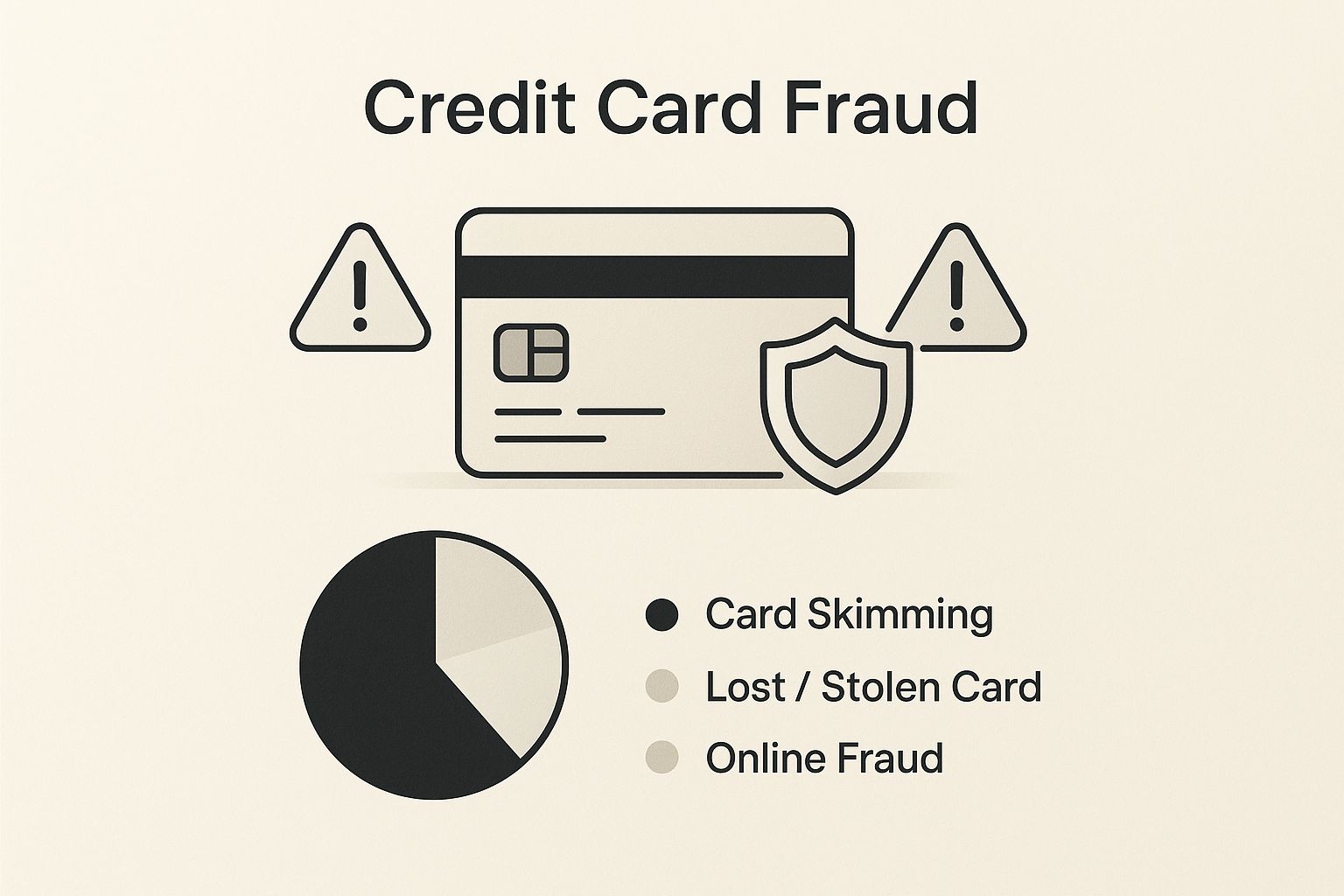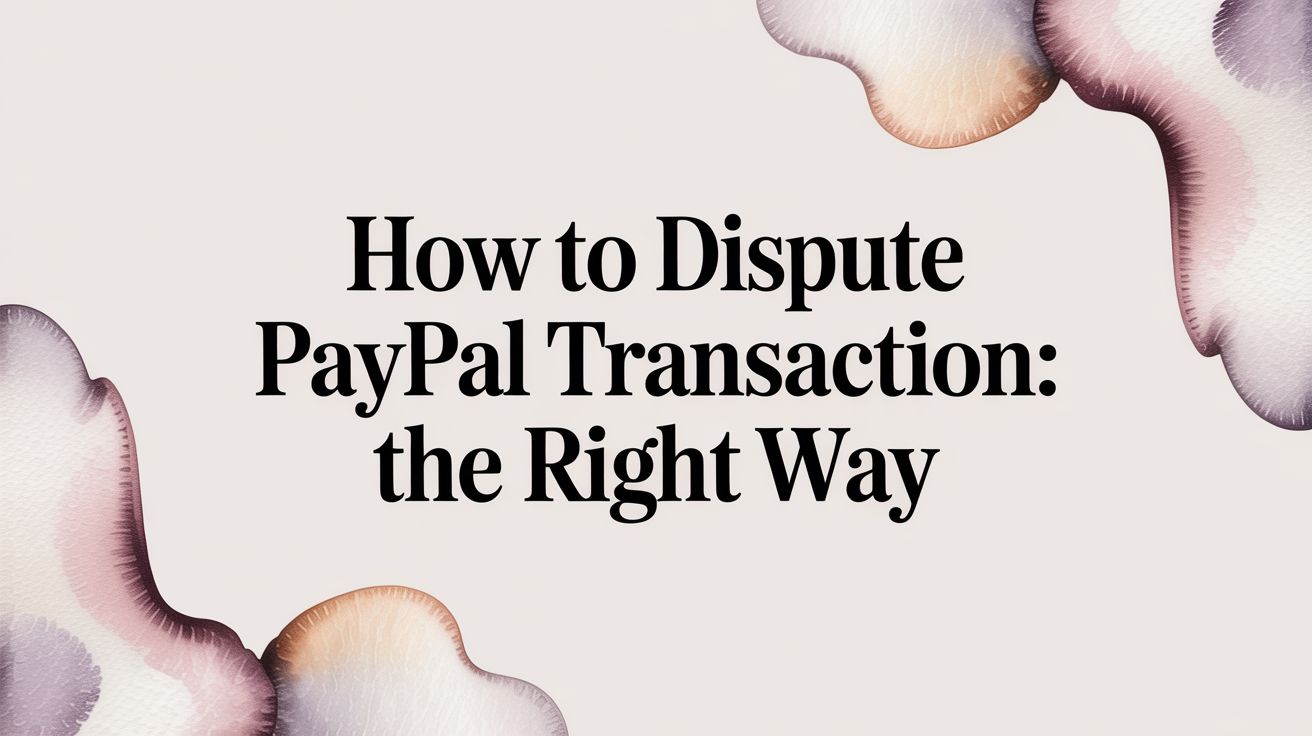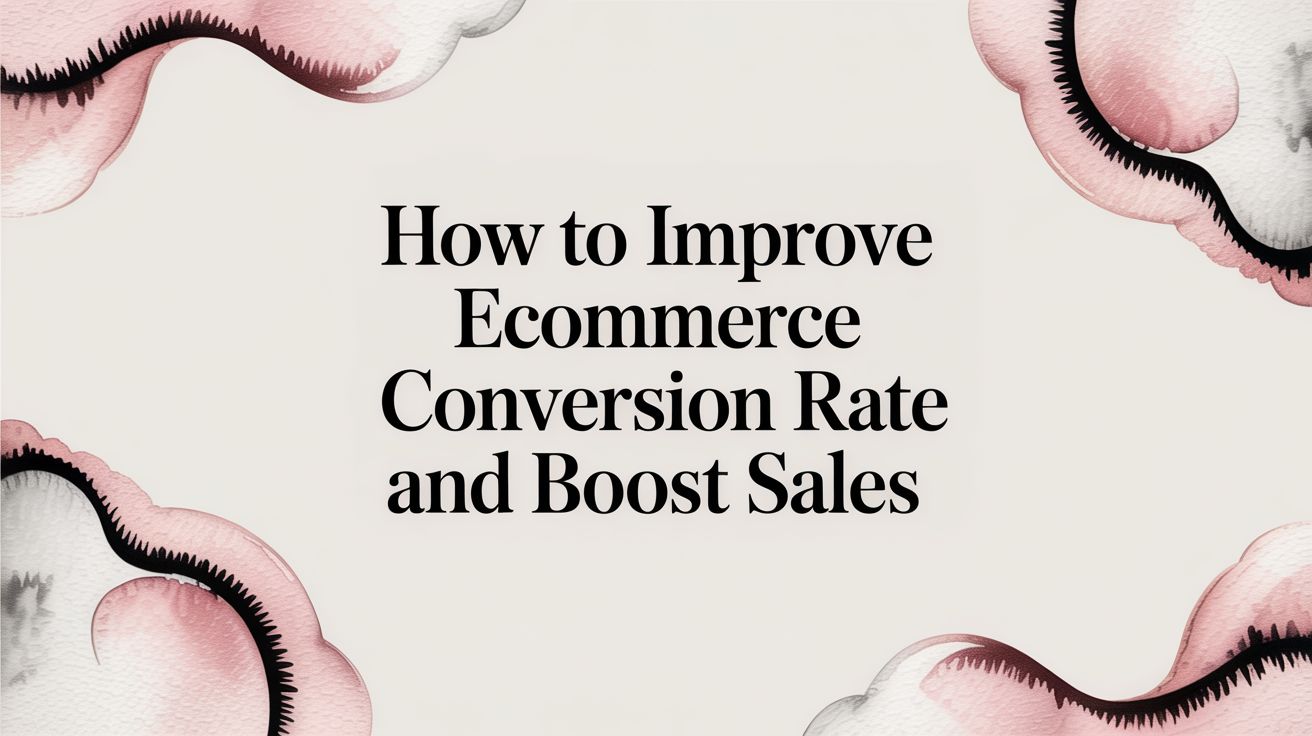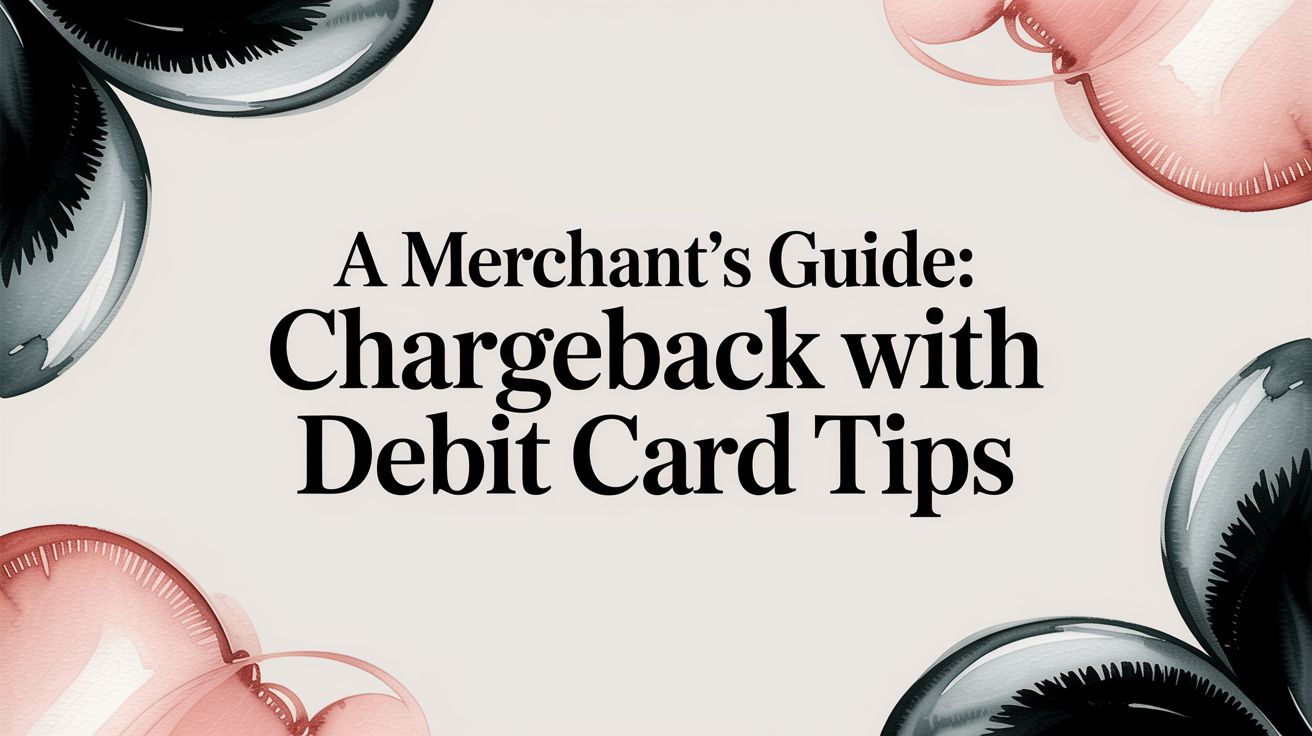
Let's be blunt: e-commerce fraud isn't just an annoying cost of doing business. It's a direct assault on your bottom line and the trust you've worked so hard to build. We're not just talking about the price of a single stolen product, either. A solid fraud prevention e commerce strategy is non-negotiable for any online store that wants to protect its revenue, keep customers happy, and actually grow.
The True Cost of E-Commerce Fraud
When you picture fraud, the first thing that probably comes to mind is the lost product and the revenue from that sale. That’s just the tip of the iceberg. The real financial damage runs much deeper, multiplying quickly and turning one bad order into a cascade of hidden costs that quietly bleed your business dry.
Let's walk through a common scenario. A fraudster snags a stolen credit card and buys a $150 pair of sneakers from your shop. You ship them out, thinking you've just made a sale. A few weeks later, the actual cardholder spots the charge and files a dispute. This is where the real pain begins.
The Financial Domino Effect
You’re not just out the $150. Your payment processor is going to slap you with a chargeback fee, which can be anywhere from $20 to $100. Just like that, your loss has ballooned to as much as $250. This is a critical detail many merchants miss, and understanding what a chargeback fee is and how it works is the first step in seeing the full picture.
But the bleeding doesn't stop there. Think about all the operational costs you've already sunk into that order:
- Wasted Labor: Someone on your team spent time picking, packing, and shipping those sneakers.
- Shipping Costs: You paid the carrier to deliver a product you'll never see a dime for.
- Lost Inventory: That pair of sneakers is gone for good. You can't sell it to a legitimate, paying customer.
This is how a single fraudulent transaction spirals out of control. In fact, for every $1 lost directly to fraud, US merchants actually end up paying an average of $4.61 when you add up all these related expenses. You can see a full breakdown of these costs in this detailed report.
The Hidden Damage to Customer Trust
The financial hit is bad enough, but the damage to your brand’s reputation can be far more devastating in the long run. When fraud is a problem at your store, it creates ripples that affect your most valuable asset: your customers.
A single bad experience—or even just the perception of poor security—can make a legitimate customer think twice before buying from you again. They start to wonder if their own data is safe, and that erosion of trust is a silent killer for your business.
This creates two massive problems. First, 64% of merchants report that fraud directly hurts their customer conversion rates. Shoppers get spooked by clunky checkout processes or just bail if the site feels insecure.
Second, 63% say it drives up customer churn. When your loyal customers feel their accounts or payment details are at risk, they’ll take their business to a competitor—and they probably won't be back.
Good fraud prevention isn't just about blocking criminals. It's about creating a secure, trustworthy environment where your real customers feel safe and confident enough to click "buy."
Recognizing Common E-Commerce Fraud Schemes
Before you can build a solid defense, you need to know what you’re up against. Fraudsters are a creative bunch and always seem to be cooking up new schemes, but most of their tactics fall into a few core categories. Think of this as your field guide for spotting trouble before it blows up into a financial loss for your business.
Criminals aren't just one-dimensional villains; they're strategic thinkers looking for the path of least resistance. Getting inside their playbook is the first real step toward building a defense that actually works.
Common E-Commerce Fraud Schemes at a Glance
Here’s a quick breakdown of the usual suspects you'll encounter in the e-commerce world. Knowing what to look for is half the battle.
This table is just a starting point. Let's dive a little deeper into how these schemes play out in the real world.
Account Takeover Fraud
Account takeover (ATO) is exactly what it sounds like: a fraudster gets into a legitimate customer's account. They don't need to steal a credit card when they can just log in and use the one your customer conveniently saved for them. This kind of attack is especially nasty because it torches your relationship with the customer while also costing you money.
Here's a classic ATO scenario: a criminal gets their hands on a list of stolen usernames and passwords from a data breach on another site. They then test those credentials on your store. Once they’re in, they might place a huge order for a hot-ticket item and have it shipped to a reshipper's address or even a vacant property. Because the order looks like it's coming from a "trusted" customer, it can easily fly under the radar of basic fraud filters.

Often, the gateway to an account takeover is a phishing attempt. That's why being vigilant and knowing the ins and outs of identifying phishing emails is so critical for both your team and your customers. The growth in online shopping has poured fuel on this fire, leading to a staggering 347% increase in ATO during the pandemic.
The Murky Waters of Friendly Fraud
Here's the tricky part: not all fraud comes from shadowy criminals. Sometimes, the threat is coming from inside the house. This is what we call "friendly fraud," or chargeback abuse, and it happens when a real customer buys something, receives it, and then tells their bank the charge wasn't valid.
It’s not always malicious. Sometimes it’s a genuine mistake, like a teenager using their parent's card without asking. But a lot of the time, it's a deliberate attempt to get something for nothing. Think of someone ordering a designer dress for a weekend event, wearing it, and then filing a chargeback to get their money back. They essentially just "rented" it at your expense.
Friendly fraud walks a fine line between customer error and deliberate deception. The challenge for merchants is distinguishing between a legitimate service issue and a customer who is simply gaming the system to get free products.
Effectively pushing back on these disputes is a whole other ballgame. For a deeper dive, check out our guide on understanding and combating friendly fraud.
Synthetic Identity Fraud
This is one of the more sophisticated tactics out there. Instead of stealing a real person's entire identity, a fraudster will stitch together a new one using a mix of real and fake information. For example, they might pair a real, stolen Social Security number with a made-up name and address.
With this shiny new "synthetic" identity, they can open lines of credit and patiently build up a good credit history. Once they've established trust, they "bust out"—maxing out every credit card and loan before disappearing completely. For your store, this might look like a new customer who makes a few small, perfect purchases over several months before dropping a massive, fraudulent order. Because some of the information is legitimate, it's incredibly tough for traditional systems to catch.
Setting Up Your Foundational Defenses
Before you even think about sophisticated AI systems, you need to lock down the basics. Think of these foundational tools as the deadbolts on your front door—they’re simple, effective, and will stop the vast majority of low-effort attacks right in their tracks. Getting these fundamentals right is the first real step in building a serious fraud prevention e commerce strategy.
The good news? These tools are often already built into your payment processor, like Stripe or Shopify Payments. You just need to flip them on and set them up correctly. They work by creating quick, simple checkpoints during checkout that are a breeze for real customers but a real headache for amateur fraudsters.
Starting with AVS and CVV Checks
Your simplest and most effective lines of defense are the Address Verification Service (AVS) and Card Verification Value (CVV) checks. Consider them your first responders in the fight against card-not-present fraud.
An AVS check is straightforward: it compares the billing address the customer types in with the address their bank has on file. If the numbers don't line up, it raises a red flag. For instance, if a fraudster has a stolen credit card number but doesn't know the cardholder's exact street address, AVS will catch that mismatch instantly.
A CVV check requires the customer to enter that three- or four-digit security code from the back of their card. Since this code isn't stored in most stolen databases, it's a pretty good indicator that the person making the purchase actually has the physical card.
These two checks are your bread and butter. Sure, they won't stop a seasoned pro, but they effectively weed out the low-effort fraud attempts. You'll be surprised how much they can reduce your chargeback rate with almost zero friction for legitimate customers.
For example, this screenshot from Stripe's documentation shows how their system, Radar, can automatically block payments that fail AVS or CVV checks.
This shows just how easy it is to set up powerful rules that automatically decline transactions showing clear signs of risk, saving you from having to manually review every single one.
The Importance of Payment Tokenization
While AVS and CVV checks protect you during the transaction, payment tokenization is all about protecting your customers' data before and after the sale. It's an absolute must-have for building long-term trust and security.
Here’s the simple version of how it works:
- A customer enters their credit card details on your site.
- Your payment gateway securely sends this data to its servers.
- The gateway then swaps the sensitive card number for a unique, non-sensitive string of characters called a "token."
- This token is what you store on your system for things like subscriptions or one-click checkouts.
The actual card number never even touches your servers. So, if your site ever suffers a data breach, the thieves only make off with a bunch of useless tokens. This dramatically cuts down your risk and liability while showing customers you take their security seriously.
Creating Basic Blocklists
Sometimes, you’ll run into fraudsters who just don't give up. They might try different cards or create multiple fake accounts to get around your other defenses. This is where a simple blocklist becomes incredibly useful.
Most e-commerce platforms give you the power to block orders based on specific criteria you set.
You can create rules to automatically block or flag orders that come from:
- Known fraudulent email addresses: If you confirm an order was fraudulent, add that email to your blocklist. No second chances.
- Specific IP addresses: Noticing multiple bad orders from the same IP? Block it.
- Certain shipping addresses: If a reshipper's address is constantly being used for fraud, you can flag any order going there for manual review.
Setting up these lists is a proactive way to shut down repeat offenders. For a deeper dive into this tactic, our guide on how to blacklist and block fraudulent customers on Shopify gives you more detailed, platform-specific steps.
Together, these foundational defenses create a solid security baseline, making your store a much harder target for criminals and paving the way for more advanced fraud prevention tools.
Using AI for Smarter Fraud Detection

So, you’ve got your foundational defenses in place. That’s a solid wall against the most common, low-effort fraud attempts. But now it’s time to add a high-tech surveillance system—one that spots the sophisticated threats your basic tools will inevitably miss. This is where AI and machine learning come in, taking your fraud prevention e commerce strategy from reactive to predictive.
Think of it like this: AVS and CVV checks are the bouncers at a club, checking IDs at the door. They’re great for catching the obvious fakes. AI, on the other hand, is the expert security guard who’s been on the job for 20 years. They can read body language, notice subtle behaviors, and sense trouble long before it starts. It’s a completely different level of awareness.
How AI Sees What Humans Cannot
An AI-powered fraud detection system crunches thousands of data points for every single transaction, all in real time. It’s analyzing a massive web of connections that no human team could ever hope to process. We’re talking about way more than just checking if a shipping address is real.
AI models are trained to spot incredibly subtle patterns that scream "fraud."
- Behavioral Biometrics: How is the user actually using your site? Are they typing and scrolling like a normal person, or are they pasting in stolen information with robotic speed? AI can tell the difference.
- Device Fingerprinting: The system creates a unique ID for every device that makes a purchase. If one device is suddenly linked to ten different credit cards in under an hour, that's a huge red flag.
- Geolocation and IP Analysis: Does the customer's IP address make sense for their billing address? Is the connection coming from a high-risk proxy server known for shady activity?
- Purchase History: An AI model can see if a "new" customer is using a device that was previously tied to a known fraudster's account. It connects the dots across your entire transaction history.
By weaving all this data together, the AI assigns a real-time "risk score" to each order. Low-risk transactions sail right through, while high-risk ones get flagged for a closer look or are blocked outright.
The Power of Machine Learning Adaptation
Here’s where it gets really good. The best AI systems get smarter over time—that's the "machine learning" part of the equation. Every single transaction, whether it’s legitimate or fraudulent, becomes a new lesson that refines the AI’s understanding of what fraud looks like specifically for your store.
Imagine a new fraud ring starts using a specific type of prepaid gift card. A static, rule-based system would be totally blind to this until you manually caught on and added a new rule to block it.
An AI model, however, would quickly spot a new pattern: a sudden spike in chargebacks is directly correlated with this new payment method. It learns on its own to assign a higher risk score to these transactions, adapting to the threat without you having to lift a finger.
This self-learning ability is what keeps you protected. Fraudsters are always changing their tactics, and an AI defense system evolves right alongside them. This ensures your protection doesn’t become obsolete the moment a new scam pops up. This adaptive response is also a massive help when it comes to managing chargeback disputes. You can see how this works in our complete guide to automated chargeback management, which breaks down how AI helps you fight and win disputes automatically.
Choosing the Right AI Solution for Your Store
Bringing AI into your fraud prevention workflow is a no-brainer, but it can feel a bit overwhelming to start. The goal is to find a solution that protects your bottom line without creating a frustrating checkout experience for your real customers. It’s a delicate balance.
One of the biggest hurdles is getting the data right. While powerful tools are essential, a recent report found that more than 80% of merchants struggle to improve their tool's accuracy with the data they have on hand. You can read the full Global Payments and Fraud Report to dig deeper into this challenge. This just goes to show that you need a solution with a powerful model that also plugs into a wider data network.
Here’s what you should be looking for in an AI fraud prevention tool:
- Easy Integration: The tool needs to connect seamlessly with your e-commerce platform (like Shopify, BigCommerce, or Magento) and your payment processor.
- A Global Data Network: The very best solutions learn from data across thousands of merchants, not just your store. This gives them a much broader, more accurate view of emerging fraud trends.
- Transparent Decisions: The system shouldn't be a mysterious "black box." It should tell you why an order was flagged, giving you clear reasons (like "high-risk IP" or "device anomaly") to help your team make smarter manual review decisions.
- A Focus on Reducing False Positives: An overly aggressive system that blocks good customers is just as damaging as letting fraud slip through. Look for a tool that prioritizes accurately separating real shoppers from criminals to protect your hard-earned conversion rates.
At the end of the day, integrating AI is about working smarter, not harder. It automates the heavy lifting of data analysis, freeing you and your team to focus on growing the business, all while a dynamic, intelligent defense works for you 24/7.
Crafting a Proactive Fraud Management Plan

Having powerful tools like AI is a huge step forward in your fraud prevention e commerce strategy, but they aren't the whole story. Technology is great at flagging potential problems, but it's your team that decides what to do next. This is where a clear, proactive fraud management plan becomes absolutely essential.
Without a consistent workflow, you risk making inconsistent decisions, wasting valuable time, and letting preventable losses slip through. A solid plan ensures every flagged transaction is handled with the same level of scrutiny, turning reactive panic into a calm, confident process.
Building Your Manual Review System
Even the smartest AI will occasionally flag an order that needs a human touch. These are the gray-area transactions—maybe they have some risky elements but don't immediately scream "fraud." Your goal is to quickly and accurately figure out if they're from a good customer or a criminal trying to beat your system.
A strong manual review process isn't about guesswork; it's about looking for specific patterns. You need to train your team to act like detectives, piecing together clues to validate an order.
Here’s a basic checklist your team can use for any flagged order:
- Check the Obvious: Do the billing and shipping addresses match? If not, is there a logical reason? A gift being sent across the country is common, but a mismatch with other red flags is suspicious.
- Look Up the Address: Pop the shipping address into Google Maps. Does it look like a legitimate residence or business, or is it a vacant lot, a P.O. Box, or a known mail forwarder?
- Investigate the Email: Does the email address look real, like
jane.smith1985@emailprovider.com? Or does it look disposable and suspicious, likeasdfghjkl@randomdomain.com? - Review Past Orders: Is this a brand-new customer placing a huge, high-risk order out of the blue? Or is it a loyal, returning customer with a perfect track record?
Let's walk through a real-world scenario. A $700 order for a new laptop gets flagged. The billing address is in California, but the shipping address is a motel in Florida. To top it off, the email is just a jumble of random letters. This combination of red flags is a dead giveaway and should lead you to cancel the order immediately.
What to Do with Flagged Orders
Once you’ve reviewed the details, you have three main choices. Your plan must clearly define the criteria for each action to ensure everyone on your team makes the same call in similar situations.
- Approve the Order: If everything checks out and you feel confident the order is legitimate, approve it. Get it sent to fulfillment and make your customer happy.
- Cancel the Order: If you see multiple, clear signs of fraud, cancel the order and refund the transaction right away. It's far better to lose one sale than to face a $700 loss plus a $25 chargeback fee.
- Contact the Customer for Verification: If you're on the fence, just reach out. A quick phone call or an email asking to confirm a few order details can often clear things up in minutes. A real customer will usually be happy to verify; a fraudster will almost never respond.
Having a repeatable process removes emotion and guesswork from the equation. It empowers your team to make fast, evidence-based decisions that protect your business without frustrating good customers.
Managing and Fighting Chargebacks
Even with the best prevention, some chargebacks are simply unavoidable. This is where your management plan shifts from prevention to recovery. Fighting illegitimate chargebacks, especially friendly fraud, is absolutely critical for protecting your revenue.
The key to winning a chargeback dispute is compelling evidence. You need to prove to the bank that you held up your end of the bargain. Your response should be organized, clear, and packed with proof.
Your evidence file for a dispute should always include:
- Order Details: A screenshot of the order from your system, showing exactly what was purchased.
- Proof of Delivery: The shipping confirmation with a tracking number, plus a screenshot from the carrier's website showing it was delivered to the customer's address.
- AVS and CVV Match: Evidence from your payment processor that the security checks passed.
- Customer Communication: Any emails, chat logs, or phone records you have with the customer about their order.
Winning disputes is just one part of a larger strategy. Effective chargeback risk management involves analyzing why chargebacks are happening and adjusting your processes to prevent them in the future. By combining a strong internal plan with smart automation, you create a robust defense that not only stops fraud but also helps you reclaim revenue that is rightfully yours.
Common E-Commerce Fraud Prevention Questions
Diving into fraud prevention can bring up a lot of questions. It's a balancing act, right? You need to protect your business, but you can't afford solutions that are impractical, too expensive, or get in the way of legitimate sales.
Let's cut through the noise and get straight to the answers for some of the most common questions I hear from business owners.
How Much Should I Spend On Fraud Prevention Tools?
Honestly, there's no magic number that fits every business. The right budget for you really boils down to your sales volume, the specific risks in your industry, and—most importantly—what fraud is already costing you.
A great place to start is by adding up your total cost of fraud. Don't just count the lost revenue from fraudulent sales. Factor in all those painful chargeback fees and the hours your team sinks into dealing with the fallout. Your investment in prevention tools should be a fraction of that total.
Many of the best AI tools today offer tiered pricing based on your transaction volume, which is a lifesaver for smaller businesses. You can always start with the basics like AVS and CVV checks (often free with your payment processor) and then scale up to more advanced systems as you grow.
Will Extra Security Checks Hurt My Conversion Rates?
This is a huge—and completely valid—concern. The absolute last thing you want is to create so much friction that good, honest customers give up and abandon their carts. The trick is to lean on "invisible" security measures as much as possible.
This is where AI-based systems really shine. They do all the heavy lifting in the background, analyzing hundreds of data points to assess risk without ever asking the customer to jump through extra hoops.
For those rare, higher-risk orders, you can use something called adaptive authentication. It’s a smarter way to add a layer of security only when it's truly necessary.
Adaptive authentication is a targeted security step. It only asks for extra verification—like a one-time code sent to a phone—when the system flags a transaction as suspicious. This keeps the checkout process buttery smooth for the vast majority of your customers while stopping fraudsters cold.
Can I Manage Fraud Prevention Myself Or Do I Need A Team?
In the very early days, you can probably handle it yourself. The built-in, automated tools that come with platforms like Shopify or payment gateways like Stripe are often enough to get you started.
But as your order volume picks up, manually reviewing every single flagged transaction becomes a nightmare. It's just not sustainable.
At that point, you've got a couple of solid options. You could designate a specific person on your team to own fraud review, or you could look into a managed service where experts handle all the monitoring for you. The goal is to make sure your fraud prevention strategy can keep pace with your business's growth.
What Is The Most Common Type Of E-Commerce Fraud?
While it can vary a bit by industry, classic payment fraud using stolen credit card information is still one of the most widespread attacks out there. It's the "card-not-present" scam we've all heard about.
But what’s really exploding right now is "friendly fraud," which is also known as chargeback abuse. This is when a legitimate customer makes a purchase but then disputes the charge with their bank to get their money back, essentially getting the product for free. Sometimes it's a mistake, but often, it's intentional.
Another major threat on the rise is account takeover (ATO). This is where a fraudster gets access to a real customer's account and uses their saved payment info to go on a shopping spree. For online retailers everywhere, ATO is a massive and growing headache.
Ready to stop losing revenue to chargebacks and fraud? ChargePay uses AI to automate the entire dispute process, generating winning evidence to recover your money without you lifting a finger. See how much you can reclaim by visiting https://www.chargepay.ai.







.svg)







.svg)
.svg)
.svg)